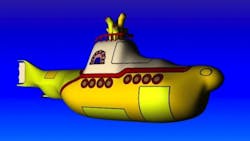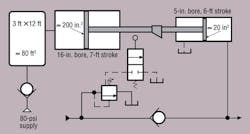The Old Timer Part 24: Remember the People Part of Design Projects
The Old Timer of Royal Oak, Mich., was a regular contributor to H&P years before we ever even heard of the internet. But most of his advice is just as useful — and interesting — today.
So rather than leave his wisdom printed on pages archived in our storage room, I pulled out issues from the late 1980s and early 1990s and have been reproducing relevant entries in this blog. Here is my 24th entry (only one more left), which was originally published in the January 1990 issue:
Remember the people part of design projects
When we were asked to speed up four large 4-poster, walking-beam, floor-pan welding machines that had a 50-gpm overhead pumping system, we first thought of accumulators. If we could store and use the oil blown over the relief valve in normal operation, we could run the welders faster and also reduce the volume of water used in the system’s heat exchangers. (Water was in short supply at that facility.)
Our initial calculation said we could double or even triple the momentary capacity of the hydraulic system by adding a 10-gal accumulator connected to four 20-gal nitrogen bottles. We proposed this to management and it went over like a lead balloon. A little accounting lesson followed: “Purchasing the accumulator components is a capital expenditure with a 15- to 20-year life. That stuff has to be written off very slowly and we’re way over budget already. So forget about buying anything.
“What we want you to do is use components we already have or can build ourselves, so the project can be written off in the first year as an expense. We just phased out a foundry division, so we have a load of surplus cylinders and valves that are going to be sold as scrap. Use them and make whatever other parts you need. Even if the project costs three or four times what the new equipment should cost, we’ll keep the accounting department happy. Also remember that we don’t need a system that’ll perform for the next 20 years; we’ll probably replace the welding line in about five years.”
With that kind of financial carte blanche, we let our imaginations run wild. Of course, we knew without saying that we were supposed to slap this equipment together in a week and install it ourselves over a weekend. That tempered our thinking considerably. So we took a quick inventory of the surplus cylinders, checked what we had in general stores, and reviewed our hidden-away cache of components. From that list we came up with our version of a piston accumulator charged with shop air rather than nitrogen.
We calculated that we could assemble an accumulator with about 6-gal capacity to provide a momentary supply of 60 gpm or more — effectively doubling flow for a short time to add the requested zap to our welders. Management loved the proposal.
We got some priority orders cut and sent my rough sketch of the surge tank to the fabrication shop. We expected some grumbling about this project, but the tank was so big and ugly that the guys took it to their hearts. Somebody with a sense of humor painted it yellow and christened it the Yellow Submarine. This was great news because we knew that any time the shop guys gave something a nickname, they accepted it and would make it work.
Over the weekend they hung our tank from the balcony, and the piping people hooked up the rest of the system. Monday was spent tuning it to tame down some of the speed. We estimated that we could cut the welding cycle time by at least 30%. We realized that would not sit well with the union steward and the operators, so we added an adjustable flow control to the accumulator line. That let us increase speed gradually over several weeks to avoid antagonizing the operators.
Once the Yellow Sub was running, adjustments and maintenance were almost nil. Cylinder rod packings and bushings were not pressurized and our alignment was precise, so they lasted indefinitely. Once the surge tank was filled, air usage was minute. Everyone could see this monstrosity easily and it wasn’t too hard for the mechanics to understand. And our prediction of reduced cooling-water usage came true.
We eventually realized that in our rush to put this equipment into service, we had forgotten a few important items:
- a water drain on the surge tank
- a safety valve on the tank
- an air shutoff valve
- a blow-down valve and gauge on the tank
- lubrication for the cylinder rods
- dust-excluding boots for the rods
- a warning sign to remind everyone that the accumulator was pressurized even when the pump was off, and
- a drain valve and gauge on the accumulator.
Low and behold—when we checked into these items, we found that they had already been taken care of by the shop people (including an inventive piping arrangement that used the drain oil from the hydraulic cylinder to lubricate the rod of the air cylinder). We now knew that our operating crew had not only accepted the Yellow Submarine but was improving it for their own safety and convenience. People made the project a success.
For an epilog, our time-study and cost guys belated got into the picture and figured that we’d pay off our total expense in six to eight months. The system ran for several years here, and last I heard, was then shipped to Mexico, where they loved it, too.
About the Author
Alan Hitchcox Blog
Editor in Chief
Alan joined Hydraulics & Pneumatics in 1987 with experience as a technical magazine editor and in industrial sales. He graduated with a BS in engineering technology from Franklin University and has also worked as a mechanic and service coordinator. He has taken technical courses in fluid power and electronic and digital control at the Milwaukee School of Engineering and the University of Wisconsin and has served on numerous industry committees.

Leaders relevant to this article:

